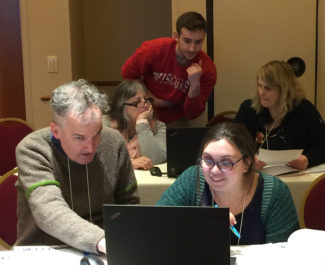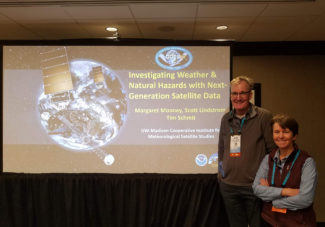2019 Virtual Science Fair for students and teachers
What is it like to work on a research project with real weather satellite data to study weather and natural hazards? Students in middle school, high school, and the first two years of college have a new opportunity this year to find out through the GOES-16/17 2019 Virtual Science Fair.
This Virtual Science Fair was devised by Margaret Mooney, director of the Cooperative Institute for Meteorological Satellite Studies (CIMSS) Education and Public Outreach Office at the University of Wisconsin-Madison and Tim Schmit, a National Oceanic and Atmospheric Administration (NOAA) scientist stationed at CIMSS, along with Vicky Gorman, a middle school teacher from Medford, NJ. They wanted to develop a novel way for students and teachers to learn satellite meteorology, participate in a small research project, and share what they learned.

Scott Lindstrom and Peter Janssen interact with teachers at the Wisconsin Society for Science Teachers. Credit: Tim Schmit
Teams of 2-4 students, with the guidance of a teacher/coach, can create and submit a scientific poster about their research, along with a video describing their poster and work. The Virtual Science Fair website offers suggestions for possible projects, as well as links to access the GOES-16/17 satellite data and resources to learn more about the satellite instrument and the data it collects.
To promote the Virtual Science Fair, Mooney and Scott Lindstrom (UW-Madison Space Science and Engineering Center, SSEC, collaborator) gave a presentation about it at the annual American Geophysical Union (AGU) meeting in December 2018, and Lindstrom and Schmit announced it during a workshop session they hosted at the recent Wisconsin Society of Science Teachers conference.
Mooney is leveraging the Virtual Science Fair to attract and support more teachers to attend the Education Symposium at the American Meteorological Society (AMS) Annual Meeting.
“One of the issues they [the AMS] wanted to address was getting teachers [to meetings],” said Mooney
Mooney explained that travel costs often prevent teachers from attending. In response, teachers of the winning Virtual Science Fair teams will receive travel support to attend and make a presentation about their students’ research at the AMS meeting in 2020.
The teachers, as well as the students on each of the winning teams, will receive invitations to the GOES-T satellite launch – though they will be responsible for their own travel costs. The invitations allow them to bring three guests and explore Kennedy Space Center for three days (the day before, day of, and day after the launch). In addition, each student on the winning teams will receive a $25 gift card.
Mooney described the Virtual Fair as the “next step” in the GOES-R Education Proving Ground program developed at CIMSS. Echoing the GOES-R program theme of launch readiness, Mooney said that they wanted teachers to be “launch ready” as well – to be able to explain to their students the importance and benefits of this weather satellite program.
“We wanted the educators to be ready to work with the data,” said Mooney. “Now that the satellites are in orbit and the data is coming down, why not get students to use it?”
For more information, visit the GOES-16/17 2019 Virtual Science Fair website. Deadline for submissions is May 3, 2019.
Funding for the Virtual Science Fair is provided by the GOES-R program.

